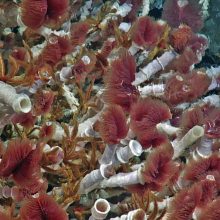Source: EurekAlert
Author: Oregon State University
CORVALLIS, Ore. – The hydrothermal vents and methane seeps on the ocean floor that were once thought to be geologic and biological oddities are now emerging as a major force in ocean ecosystems, marine life and global climate.
However, even as researchers learn more about their role in sustaining a healthy Earth, these habitats are being threatened by a wide range of human activities, including deep-sea mining, bottom trawling and energy harvesting, scientists say in a report published in Frontiers in Marine Science.

Researchers from Oregon State University first discovered these strange, isolated worlds on the ocean bottom 40 years ago. These habitats surprised the scientific world with reports of hot oozing gases, sulfide chimneys, bizarre tube worms and giant crabs and mussels – life forms that were later found to eat methane and toxic sulfide.
“It was immediately apparent that these hydrothermal vents were incredibly cool,” said Andrew Thurber, an assistant professor in the OSU College of Earth, Ocean and Atmospheric Sciences, and co-author on the new report.
“Since then we’ve learned that these vents and seeps are much more than just some weird fauna, unique biology and strange little ecosystems. Rather than being an anomaly, they are prevalent around the world, both in the deep ocean and shallower areas. They provide an estimated 13 percent of the energy entering the deep sea, make a wide range of marine life possible, and are major players in global climate.”
For more, go to: http://www.eurekalert.org/pub_releases/2016-05/osu-hvm053116.php

